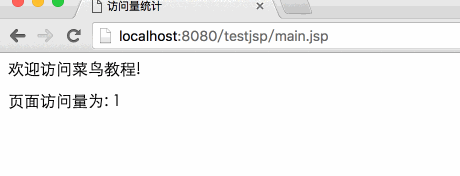JSP 点击量统计
有时候我们需要知道某个页面被访问的次数,这时我们就需要在页面上添加页面统计器,页面访问的统计一般在用户第一次载入时累加该页面的访问数上。
要实现一个计数器,您可以利用应用程序隐式对象和相关方法getAttribute()和setAttribute()来实现。
这个对象表示JSP页面的整个生命周期中。当JSP页面初始化时创建此对象,当JSP页面调用jspDestroy()时删除该对象。
以下是在应用中创建变量的语法:
application.setAttribute(String Key, Object Value);
您可以使用上述方法来设置一个计数器变量及更新该变量的值。读取该变量的方法如下:
application.getAttribute(String Key);
在页面每次被访问时,你可以读取计数器的当前值,并递增1,然后重新设置,在下一个用户访问时就将新的值显示在页面上。
实例演示
该实例将介绍如何使用JSP来计算特定页面访问的总人数。如果你要计算你网站使用页面的总点击量,那么你就必须将该代码放在所有的JSP页面上。
<%@ page language="java" contentType="text/html; charset=UTF-8"
pageEncoding="UTF-8"%>
<%@ page import="java.io.*,java.util.*" %>
<html>
<html>
<head>
<title>访问量统计</title>
</head>
<body>
<%
Integer hitsCount =
(Integer)application.getAttribute("hitCounter");
if( hitsCount ==null || hitsCount == 0 ){
/* 第一次访问 */
out.println("欢迎访问菜鸟教程!");
hitsCount = 1;
}else{
/* 返回访问值 */
out.println("欢迎再次访问菜鸟教程!");
hitsCount += 1;
}
application.setAttribute("hitCounter", hitsCount);
%>
<p>页面访问量为: <%= hitsCount%></p>
</body>
</html>
现在我们将上面的代码放置于main.jsp文件上,并访问http://localhost:8080/testjsp/main.jsp文件。你会看到页面会生成个计数器,在我们每次刷新页面时,计数器都会发生变化(每次刷新增加1)。
你也可以通过不同的浏览器访问,计数器会在每次访问后增加1。如下所示:

复位计数器
使用以上方法,在 web 服务器重启后,计数器会被复位为 0,即前面保留的数据都会消失,你可以使用以下几种方式解决该问题:
- 在数据库中定义一个用于统计网页访问量的数据表 count,字段为 hitcount,hitcount 默认值为0,将统计数据写入到数据表中。
- 在每次访问时我们读取表中 hitcount 字段。
- 每次访问时让 hitcount 自增 1。
- 在页面上显示新的 hitcount 值作为页面的访问量。
- 如果你需要统计每个页面的访问量,你可以使用以上逻辑将代码添加到所有页面上。
------------------------------------------------------------------------------------------------------------------------------------------------------------------------------------------------------
方式二.session和application加文本或者数据库保存结合就完美了,不管重启服务器,还是能百分百记录所有的访问记录。
public class Counter extends HttpServlet {
private static final long serialVersionUID = 1L;
public Counter() {
super();
}
public static void writeFile(String filename, int count) {
try {
PrintWriter out = new PrintWriter(new FileWriter(filename));
out.println(count);
out.close();
} catch (IOException e) {
e.printStackTrace();
}
}
public static int readFile(String filename) {
File f = new File(filename);
int count = 0;
if (!f.exists()) {
writeFile(filename, 0);
}
try {
BufferedReader in = new BufferedReader(new FileReader(f));
try {
count = Integer.parseInt(in.readLine());
} catch (NumberFormatException e) {
e.printStackTrace();
} catch (IOException e) {
e.printStackTrace();
}
} catch (FileNotFoundException e) {
e.printStackTrace();
}
return count;
}
public void init() throws ServletException {
// Put your code here
}
}
页面编码如下
<%@ page language="java" import="java.util.*" pageEncoding="utf-8"%>
<%@ page import="com.tozhan.cn.GetDataDB" %>
<%@ page import="com.tozhan.cn.news.New" %>
<%@ page import="com.tozhan.cn.Counter" %>
<%
Counter CountFileHandler=new Counter();//创建对象
int count=0;
if(application.getAttribute("count")==null){
count=CountFileHandler.readFile(request.getRealPath("/")+"count.txt"); //读取文件获取数据赋给count
application.setAttribute("count",new Integer(count));
}
count=(Integer)application.getAttribute("count");
if(session.isNew()) ++count;
application.setAttribute("count",count);
CountFileHandler.writeFile(request.getRealPath("/")+"count.txt",count);//更新文件记录
%>
<p>我们的友谊海枯石烂! 你是第 <%=count %> 位访客</p>
